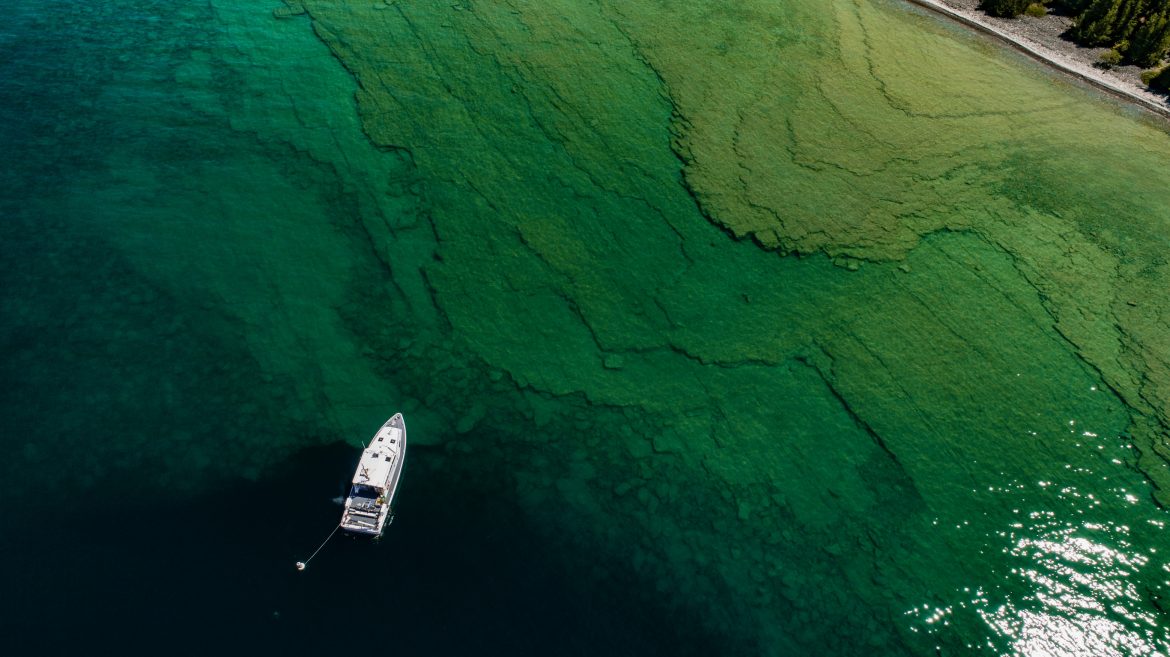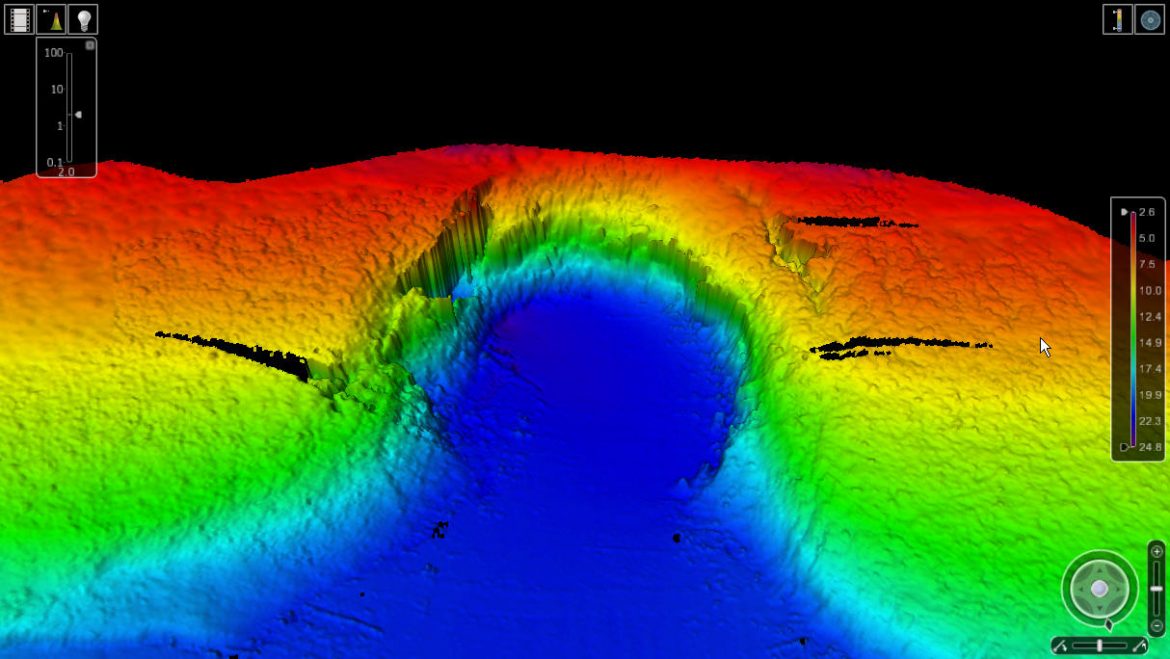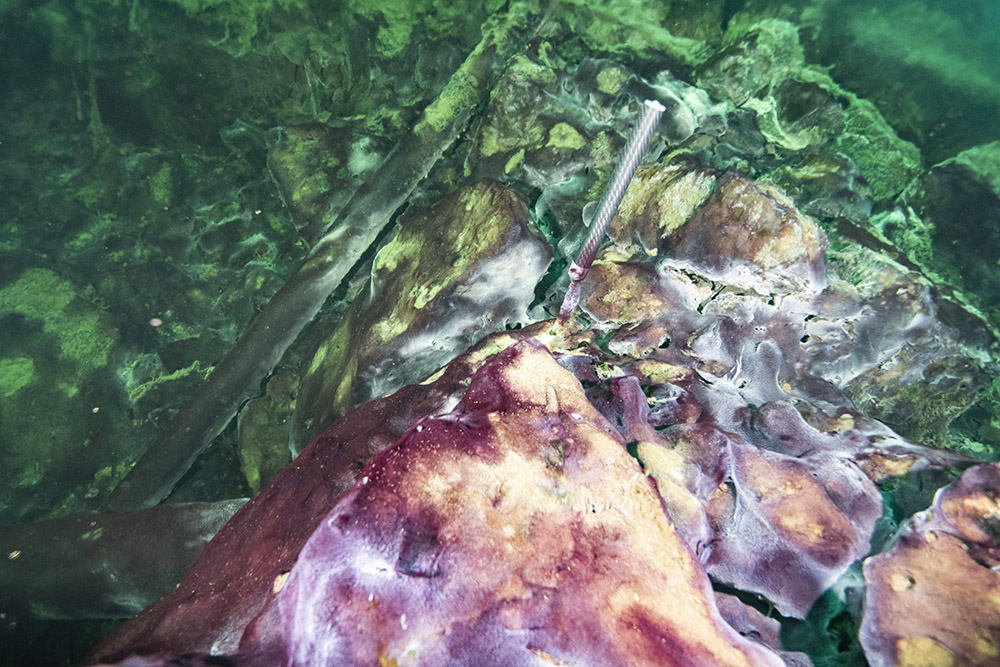
Research boat explores a sinkhole on the northern edge of Rockport’s Middle Island. Image: NOAA/David Ruck, Great Lakes Outreach Media
By Carin Tunney
Scientists will return to Lake Huron this summer to explore one of the deepest mysteries of the Great Lakes – underwater sinkholes.
Lake Huron sits on a layer of 400-million-year-old limestone – the remnants of an ancient seabed. Groundwater runs vertically under the lake and pushes through the limestone, making deep, underwater sinkholes, said Steve Ruberg, a researcher with the National Oceanic and Atmospheric Administration’s Great Lakes Environmental Research Laboratory, which leads the research that begins this August. The project includes scientists from across Michigan and Wisconsin.
Much of the mystery involving the sinkholes relates to a unique “microbial community” that includes a type of cyanobacteria that live on sulfur and other bacteria. Cyanobacteria are one of the oldest organisms on Earth. They are notable for their ability to switch between oxygen and sulfur to produce the energy they need through photosynthesis.
The billions of years old cyanobacteria may hold the secret of how Earth went from inhabitable to habitable, sustaining plant and animal life.
Scientists with the Thunder Bay National Marine Sanctuary in Alpena, Michigan, first discovered deep depressions in the Great Lakes about 20 years ago while searching for shipwrecks. Advanced techniques to map underwater environments helped scientists identify the depressions as sinkholes. Scientists used to think sinkholes only existed in oceans.

The sonar image shows the depth of the sinkhole. Blue represents 65 foot depth, while red and yellow indicate about 15 feet deep. Image: NOAA
There is a lot to learn about these underwater ecosystems, Ruberg said.
“When you look at the Great Lakes, we have a good understanding of ecosystems and how things work,” he said. “But the remarkable thing is how little of the bottom areas we have mapped and how little we understand.”
Scientists explore sinkholes with divers, multi-beam sonar and robotic vehicles. The sinkholes average about 330 feet in diameter.
They’ve retrieved samples from about 410 feet below the surface, but some sinkholes may be deeper, Ruberg said. There are both nearshore and offshore sinkholes. Previous research projects gathered water samples from one about 16 miles from the coastal community of Rockport, Michigan.
Researchers said exploring sinkholes may lead to the discovery of new organisms. The cyanobacteria found in offshore sinkholes have genetic markers only seen in the ocean off the coast of Africa. Those closer to the shore are matched to organisms found in ice-covered lakes in Antarctica.
“So, the mystery here is pretty incredible,” Ruberg said. “It wouldn’t be surprising if we found something, a microbe that had not been found anywhere else.”
Greg Dick, an associate professor of earth and environmental science at the University of Michigan, said the cyanobacteria may also hold secrets about early earth before plants and animals evolved. Cyanobacteria were the first organisms to produce oxygen and make life on earth possible.
“We are hoping to learn what controls oxygen production systems with hope of understanding how that might inform our knowledge about how this earth became what it is, how it became habitable,” he said.
Dick also studies the relationship between the cyanobacteria and other organisms that form extremely rare “carpets of microbes” that look like dense purple mats inside the sinkholes. He said the mats may explain why oxygen production is limited to earth.

Microbial mats made of cyanobacteria and other organisms may hold answers about life on earth. Image: Phil Hartmeyer/Thunder Bay Marine Sanctuary
“The big picture thing is that we have this really extreme and unique environment right here in our backyard in our Great Lakes,” Dick said. “I think that these mats rival ecosystems like Yellowstone National Park and ice-covered lakes in Antarctica. So, for me, I’ve spent my career going to the bottom of the ocean and all over the world, and it’s really exciting to have these environments right in our Great Lakes.”
Another unique quality of cyanobacteria is that it can potentially be combined with antibodies to make pharmaceuticals, said David Sherman, a researcher with the University of Michigan’s Life Science Institute.
“We can tell a lot of the capabilities are to make certain types of biologically active peptides, so these are very simple proteins,” Sherman said. “These smaller peptides are often very biologically active, and the one that is currently FDA-approved that comes with the cyanobacteria is used for a cancer agent … the peptide is what kills the cancer cells, the antibody is like a guided missile that attaches to the cancer cells.”
Scientists also study how groundwater pushing up from sinkholes influences Great Lakes water levels. Ruberg said it’s another aspect of sinkholes that is not well understood and could have a small effect on lake levels.
Great Lakes Outreach Media produced a short film earlier this year that highlights the fieldwork involved in sinkhole research.
In the context of thought, underwater sinkholes. Fresh water Great Lakes vs Ocean. Don’t need it any more complicated.
CaveDiver, dove the Eagles Nest. C.F.
I find the statement about not knowing there are sinkholes in GLs strange. Something is not correct in the way it is written in the article. As a kid fishing on Lake Huron we knew were all the sink holes in our area were, as we would fish them for perch in their cooler waters. We called them perch sinkholes or perch holes.
Interesting. Spent my entire life living here on Lake Huron. 67 yrs & counting.
Seems there are some issues with the content. “Scientists only thought that sinkholes occur in oceans.” Actually, there are lots of examples of sinkholes that occur on the land surface. Humans have known about sinkholes since before recorded history. Some of the best examples of sinkholes include southern Indiana, Florida (where they swallow houses) or the the sinkhole plain around Mammoth Cave, Kentucky.
During construction of the Bruce B Nuclear Power plant the cooling water intake tunnel was being drilled under the lake bed. About halfway out it hit one of these sinkholes. They tried to fill it with grout but it was too big so the tunnel was diverted around it.
This hasn’t anything to do with above content, I just wanted to say thunder Bay is a beautiful area, I’m from So Florida and just enjoyed that area immensely and the marina was quiet proper. Along the coast of Michigan there is a marina every 30 miles
Very interesting. I live in Honey Harbour (south east Georgian Bay) and always looking for news on the Great Lakes, specifically G.Bay
Inhabitable and habitable mean the same thing. Who is progressing this stuff, kindergarteners?
As a confirmed southerner – born in South America, lived my early childhood on several islands of the Caribbean and the next 80 years in the south and southwest of the U.S.- I am lately come to Michigan and am fascinated by the Great Lakes and their power to effect the weather and other conditions of this whole area. I would truly enjoy receiving periodic information about the research you are doing on the sinkholes of the Great Lakes.
Thank you,
Sydney King
P.O. Box 369
Lexington, MI 48450
P.S. I have 2 masters degrees and was a high school assistant principal and principal for a number of years and enjoy the reading and study of educational material.
I love this. And hope we can explore this while resisting the urge to monetize any findings. Then again it’s hard for it to pay for itself.